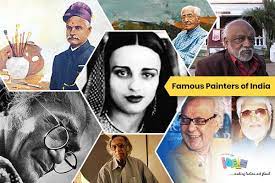5 Famous Painters Of India With Their Well-Known Works

While we study various Indian paintings and famous painters of India, India has seen a rich sense of culture and history in this subject. The artists of ancient India, on the other hand, who created exquisite works such as the murals in the caves of Ajanta and Ellora, are unknown. Raja Ravi Varma was one of the first well-known Indian artists, fusing Western creative skills with a distinctly Indian sensibility.
European influences in Indian art emerged as a result of British control and their educational system. The Bengal School of Art, led by Abanindranath Tagore, was instrumental in shifting the Indian art scene away from western influences and toward traditional Indian aesthetics. The Progressive Artists’ Group (PAG), which was created in 1947, combined inspirations from Indian art history with western techniques. S. H. Raza, M. F. Husain, and Tyeb were among the artists who later acquired international fame.
List of Famous Painters of India
1. Tyeb Mehta
Tyeb Mehta was a painter, sculptor, and filmmaker who was a member of Mumbai’s Progressive Artists’ Group (PAG). He met many painters who would subsequently become famous, like S. H. Raza and M. F. Husain, when he was there. The PAG abandoned the nationalist Bengal school in favor of a style that was largely influenced by Western Modernism.
In 1959, Mehta relocated to London, where he remained until 1964, after which he traveled to New York City. Mehta was motivated by the grotesque distortions of prominent British artist Francis Bacon when in London, and his work became characterized by Minimalism while in New York. He later shifted to Indian themes and subjects in the 1970s and 1980s.
2. Satish Gujral
A pre-partition West Punjab native, Satish Gujral enrolled in the Mayo School of Art in Lahore in 1939 and the Sir J.J. School of Art in Mumbai in 1944. However, due to a chronic illness, he had to drop out of school in 1947. Gujral received a scholarship to study at Mexico City’s Palacio de Bellas Artes in 1952.
He studied under Diego Rivera and David Alfaro Siqueiros, two well-known Mexican artists. Satish Gujral went on to become one of India’s most prominent artists after independence. He arranged art events in various places throughout the world from 1952 to 1974, including New York City, New Delhi, Montreal, Berlin, and Tokyo. Gujral is noted for his wide range of interests.
3. Rabindranath Tagore
He was an artist as well as a poet who won the Nobel Prize for Literature. He started painting in his sixties, late in his career. Though he started with doodling, he went on to create a wide range of imagery, including fantasy and weird monsters, masks, mysterious human faces, mystic landscapes, birds, and flowers.
Tagore went on to create thousands of works of art, becoming the first Indian artist to display his work in Europe, Russia, and the United States in 1930. Tagore’s art is highly unique, with bold forms, vibrancy, a feeling of rhythmic quality, and a sense of imagination. It should be emphasized that Tagore was most likely colorblind in the red-green spectrum.
4. Nandalal Bose
Being the pioneers of modern India, Nandalal Bose was also known as the Artist laureate of India. He is also called the key figure of Contextual Modernism. As the Indian independence struggle raged on, Nandalal Bose, along with other famous artists, tried to change the Indian art scene away from the western influences that were widespread at the time at art schools.
Bose was primarily influenced by the 5th century murals in Ajanta Caves, rather than western art, and he substantially stole ideas and motifs from them. He also toured widely over India, observing different Indian art forms. When India gained independence, the Prime Minister of India ordered Nandalal Bose to design the emblems for the Government of India’s awards, including the Bharat Ratna, India’s highest civilian honour.
5. Jamini Roy
Jamini Roy began his career as a painter of landscapes and portraits in the Post-Impressionist style. His art reflected European influences, which matched his education in a British academic system. Roy, however, entirely shifted his approach from his academic Western background to a new style based on Bengali folk traditions in the mid-1920s. As a result, traditional Bengali painting impacted both his skills and subject matter. Jamini Roy’s painting was largely intended to capture the simplicity of the common people’s lives. He also desired to make art more accessible to a wider audience and to give Indian art a distinct identity. Kalighat painting, an Indian style of art with powerful sweeping lines, affected Jamini Roy the most.
Wrap up:
It is very important to learn about famous painters of India. They have not only contributed to the rich culture of Indian; but also ensured that the world knows their art and country. While mesmerising the art, you can also look in for onsite art galleries that will ensure great master pieces of such for your home and office decor. Get a chance to change your interiror with world class room decore paintings.



